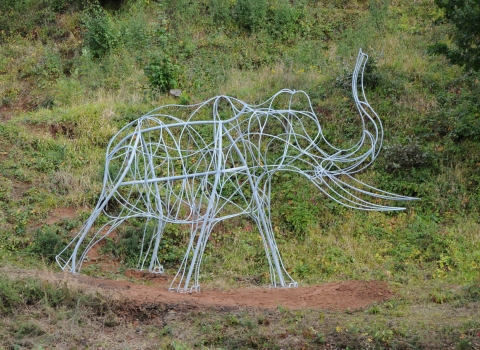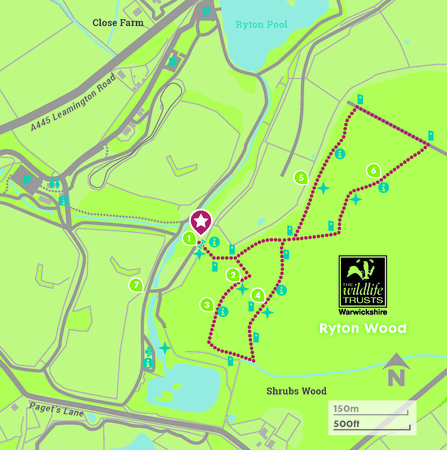
Credit Lucy Hawker
Ryton Wood Figure of Eight Walk
Head into Ryton Wood and explore a figure of eight trail. This trail is part of the Dunsmore Living Landscape scheme. Use the map below as a guide to your walk.

Waymarked Figure of Eight Trail
- Start your walk by heading into Ryton Wood via the entrance from Ryton Pools Country Park. Check out the carved totem pole and interpretation board by the gate. Head towards the first waymarker and continue to follow subsequent waymakers as they direct you around the Figure of Eight Trail.
2. Wooden carvings
Take a look at our carved bluebell and owl bench.
3. Feature post
As you continue along the path, you will come across a feature post revealing a site of ecological or historical significance in the wood as well as acting as a reminder to pause, look and listen. Look out for the others along the trail.
4. Wooden carving
Appreciate our carved snail bench amongst the woodland flora.
5. Pause and listen
After the seventh waymarker, take a break at our carved hedgehog and rabbit bench and try and listen out for the drumming of the great spotted woodpecker.
6. Last set of feature posts
You are now at the last set of feature posts and carved benches on the trail. Soon after, turn right at the tenth waymarker and follow the path until you reach the entrance of Ryton Wood.
7. Elephant sculpture
Before heading back to Ryton Pools Country Park Visitor Centre, take a detour to your left at the junction to visit our sculptures of a Straight-tusked elephant adult and calf nearby the sand martin hotel. These reflect important paleontological finds made on site during quarrying. Why not take a picture and tag us @ExploreDunsmore and let us know what you thought of our Figure of Eight Trail.
Download the walk leaflet
Discover more about this wonderful woodland
Ryton Wood is one of the country’s largest surviving semi-natural ancient woodlands
Although part of Ryton Wood was lost to sand and gravel extraction in the 1960s, the wood has been returned to its present excellence though traditional management practices, and is one of the county’s largest surviving semi-natural ancient woodlands.
Arguably the best of the Princethorpe Woods, Ryton Wood covers 85 hectares, has been designated as an SSSI and boasts an extensive list of notable species.
Parts of Ryton Wood date back to the 11th century, so the land may have been wooded since the end of last ice age. Finding coppiced, small-leaved lime stools is evidence to support this. Once the most common tree 5,000 years ago, the species is no longer so common. Huge ditches also indicate the wood’s ancient, medieval boundaries.
Forty or so species of tree and shrub have been identified, with oak the dominant tree. An abundance of honeysuckle, our county flower, scrambles through the lower-growing hazel – enjoy its sweet perfume on summer days.
In Spring primrose, wood anemone and yellow pimpernel carpet the woodland floor. The rides though the wood are grassy and bright, bringing extra light for plants such as barren strawberry and common spotted orchid. Broad-leaved helleborine grows well at the dappled edges of the rides. In the large, clear glades there are fabulous bluebell displays.
For bug-lovers there is plenty of variety to be found in the wood plus its one of the best sites for butterflies in Warwickshire. Species to be seen include white admiral, purple hairstreak and silver-washed fritillary. Regular recordings of moths have recognised an impressive 570 species, of which four are nationally scarce.
